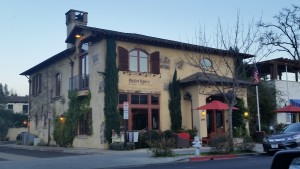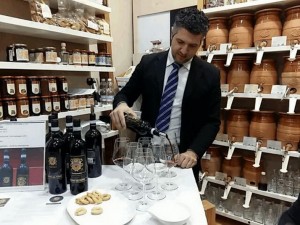In most cases, the best way to go wine tasting is to drive out into the countryside; see the vines; snatch a grape or two if it’s harvest time; and get to know the area where the wine is produced. But there are times when this is not necessarily the best idea. In the Napa and Sonoma Valleys on a weekend (especially a holiday weekend); in Europe during the vendange, in remote areas where just getting from place to place takes up too much time it is often best to look for other alternatives. One of these is to do your tasting in a town, rather than in the vineyards.
It’s a bit unfair to the wineries that have opened in-town tasting rooms, but most of these have, for a long time, been pretty terrible. We are happy to report that this is no longer the case, at least not everywhere. There are reasons to stay in town, but there are also drawbacks.
Priest Ranch in Yountville, CA
Perhaps the greatest advantage of tasting in town is that you don’t have to drive from winery to winery. A very little shoe leather will take you from one to the next. On the other hand, unless you are staying in the same town, you do have to get back behind the wheel to go home. So the plus is you can taste more wine without driving but that’s the minus as well. Take it slow and easy in town just as you would out among the vines.
When you taste in towns, you trade off the beauty of the trees, sky, lanes and vines for the less ethereal attraction of cafes, shops and everyday life. In Santa Barbara, for example, the tasting rooms are in two main locations: along the railroad tracks in the aptly named Funk Zone and uptown in shopping centers. Neither of these are necessarily bad, but a lot of the artistry or wine is lost in an atmosphere that is either party time (!) or commercial.
You lose a connection with the terroir is towns. The wines are there because that’s where the owner opened the room, not because the wines come from right around that area. Again using Santa Barbara as an example, many of the wines you can taste are from Santa Barbara County, but many are from Santa Maria, San Luis Opisbo or even Sonoma Counties. There’s wine there, but no there’s no there there.
In Italy, in our experience, wineries don’t open tasting rooms in town. For one thing, the vineyards are just outside the towns, within a few minutes’ drive. For another, many of the towns are too small to attract visitors. They are little more than a few houses gathered around a crossroad. Exceptions include Montalcino and Montepulciano in Tuscany, where you find sale di degustazione that feature certain wineries that they represent. You pay a fee and you get a guided tour of the region, sitting on a bar stool. It always felt like a shame to us to be there when the real vineyards were just down the road.
A degustazione in Montalcino. Photo courtesy of Sempione News
Virtually every village in France’s wine growing regions has a cooperative, where the farmers who don’t have the money or interest to make wine for sale on their own band together for common facilities and marketing. If, as happened to us in Beaujolais during the last harvest, none of the wineries are open, the cooperatives are there to give you an idea of what the regions’ wines are like. In some, sadly, all you get is a distant hint of the greatness in that denomination, not the true glory of the AOC. There are some great exceptions, such as in Rasteau or Chablis.
There is hardly anything more pleasant than passing an afternoon taking in the scene in the street or on the piazza or the petit place sipping lovely wines. As with everything else having to do with adult beverages, that pleasure should be indulged with discretion. We like tasting in town sometimes, but we know where the real magic of Wine Country comes from, too, and it’s not on the streets.


